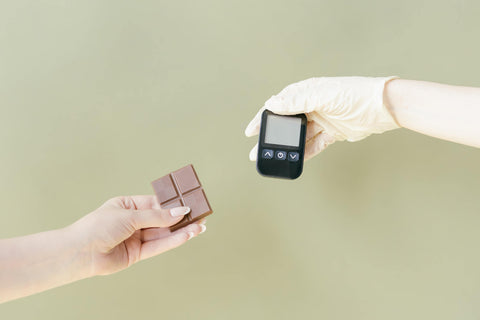l ) Glycemic Index (GI) :
It is a ranking system that indicates how quickly a carbohydrate-rich food raises blood glucose levels. This is determined by measuring the area under the curve of the two hours following the consumption of a test food. It is widely used in managing blood sugar levels in diabetics. Generally, there are three categories of foods based on their GI: high GI foods (> 70), intermediate GI foods (> 55 - < 70), and low GI foods (< 55).
What is blood glucose ?
Blood glucose is the measurement of the amount of sugar per liter of blood. Normal blood glucose levels range between 0.8 and 1.2 grams of sugar per liter of blood. Below this range is considered hypoglycemia, while above it is considered hyperglycemia. Blood glucose levels can vary depending on various factors such as diet, physical activity, stress, medications, and hormonal imbalances. It is important to regularly monitor blood glucose levels, especially for people with diabetes. This can be done using a glucometer, a portable device that measures blood glucose levels using a small drop of blood.
When should I check my blood glucose ?
- In the morning, fasting : This is often the first test of the day, before consuming anything.
- Before meals : It is useful to check your blood glucose before each meal to understand how your body reacts to food.
- Two hours after a meal.
- Before going to bed.
- Before and after exercise : Physical activity can affect blood glucose levels.
What happens when we consume carbohydrates ?
When we consume carbohydrates, they are digested and broken down by our digestive system into glucose molecules, which are then absorbed into the bloodstream. After consuming carbohydrates, our blood sugar level (glycemia) increases. Then the pancreas secretes a hormone called insulin. Insulin allows glucose to enter the body's cells, where it is used as an energy source or stored as glycogen in the muscles and liver for later use.
If our carbohydrate consumption is excessive or if our body does not respond properly to insulin (such as insulin resistance or diabetes), it can lead to hyperglycemia, which is high blood sugar levels.
Why choose low glycemic index carbohydrates ?
Consuming low glycemic index (GI) foods has several health benefits. Here are some reasons why it is beneficial to prioritize low GI foods :
-
Blood glucose control: Low GI foods result in a slower and more gradual increase in blood glucose compared to high GI foods. This means that blood sugar levels increase more gradually and remain more stable, avoiding spikes and sudden drops in blood glucose.
-
Heart health : Low GI diets have been associated with a reduced risk of cardiovascular diseases. Low GI foods are often rich in fiber, nutrients, and antioxidants, which can help maintain good cardiovascular health.
-
Weight management : Low GI foods are generally more filling and can help control appetite. They promote a lasting feeling of fullness, which can contribute to more effective weight management by reducing cravings and overeating.
-
Stable energy : Low GI foods provide a slower and more sustained release of energy. They avoid energy spikes followed by sharp drops, which can help maintain stable energy levels throughout the day.
-
Disease prevention : Low GI diets have been associated with a reduced risk of developing certain diseases such as type 2 diabetes, heart diseases, and certain types of cancer. Low GI foods are often rich in fiber, vitamins, minerals, and antioxidants, which have beneficial effects on health and disease prevention.
What factors can affect the glycemic index of a food ?
- Processing : In general, the more processed a food is, the higher its GI. Cereals that have been ground and refined.
- Food Combinations : When carbohydrate-rich foods are consumed as part of a meal, the GI of the meal changes based on the average of all the glycemic indices.
- Cooking Time : Longer cooking times can increase the glycemic impact of a food by breaking down starch or carbohydrates and allowing for faster digestion.
- Acidity : The more acidic a food is (e.g., pickled foods or those containing vinegar or lemon juice), the lower its GI.
- Physical structure : The fibrous layer around beans, seeds, and the cell walls of whole grains acts as a physical barrier, slowing down the access of digestive enzymes to break down carbohydrates. Therefore, many whole grains and legumes have a lower GI.
- Protein/Fat : Adding proteins or fats, which have minimal effects on glycemic excursions, to a high GI food will reduce the GI of that food.
- Soluble fiber : In general, the higher the content of viscous or soluble fibers in a food, the lower its GI. Fiber-rich foods do not contain as many digestible carbohydrates, which slows down the rate of digestion and results in a more gradual and less pronounced increase in blood sugar.
- Ripeness : Ripe fruits and vegetables tend to have a higher glycemic index than unripe ones.
How to reduce the glycemic index of a food ?
- Replace a portion of flour in certain preparations (cake, pie) with almond flour.
- Choose whole grains : Replace refined grains with whole grain versions that contain more fiber and nutrients, which slow down the digestion and absorption of carbohydrates.
- Add a little acidity (lemon juice or vinegar).
- Consume foods cold. For example, a steamed potato has a high GI (88). However, when cold in a salad, its GI drops to 58 (moderate). In fact, as it cools, the starch in the potato changes and becomes more resistant to digestion.
- Cook foods for a shorter period.
- Prefer gentle cooking methods: Some cooking methods, such as steaming, simmering, or baking, better preserve the structure of foods and can help maintain a lower GI.
- Consume fermented foods : Fermented foods, such as plain yogurt or sauerkraut, can have a positive effect on the GI of meals. The beneficial bacteria present in fermented foods can help slow down the digestion of carbohydrates.
Disadvantages of the glycemic index :
- The GI does not take into account the normally consumed quantity.
- The GI does not take into account the proportion of carbohydrates in the food.
- The GI does not take into account the nutritional quality of the food.
ll ) Glycemic Load (GL) :
It is a concept closely related to the glycemic index (GI) that takes into account both the quality and quantity of consumed carbohydrates. While the GI measures how quickly a carbohydrate-rich food raises blood glucose, the GL considers the total amount of carbohydrates in a given portion of food. However, the glycemic load is a more concrete and practical concept.
The GL is classified into three categories :
- Low glycemic load : GL less than 10
- Medium glycemic load : GL from 11 to 19
- High glycemic load : GL greater than 20
How to calculate ?
GL = GI × available carbohydrates (g) / 100.
Available carbohydrates = total carbohydrates - dietary fiber.
The glycemic load can be a useful tool in managing blood sugar, especially for people with diabetes or those looking to control their weight. By choosing foods with a lower glycemic load, one can promote a more gradual increase in blood sugar and avoid blood sugar spikes.
A food with a high GI can have a moderate GL if the amount of consumed carbohydrates is low. Therefore, it is essential to consider both the GI and the quantity of carbohydrates when evaluating the glycemic load of a meal or diet.
For example :
Carrots, which we may believe will significantly raise blood sugar.
Values may vary slightly depending on the size and variety of carrots, as well as their degree of ripeness.
In general, an average carrot weighing about 61 grams contains approximately 6 grams of carbohydrates and 2 grams of fiber. Using the formula for GL, we can calculate the approximate glycemic load of a carrot.
Carrots have a relatively low glycemic index of about 35. Taking into account the available carbohydrate quantity of 4 grams (6 grams of carbohydrates minus 2 grams of fiber), we can calculate the GL :
GL = 35 (carrot's GI) × 4 (available carbohydrates quantity) / 100 = 1.4
Therefore, the approximate glycemic load of an average carrot would be around 1.4.
It is important to note that the low glycemic load of carrots indicates that they have a low impact on blood sugar when consumed in reasonable amounts.
Sources : https://www.ncbi.nlm.nih.gov/



